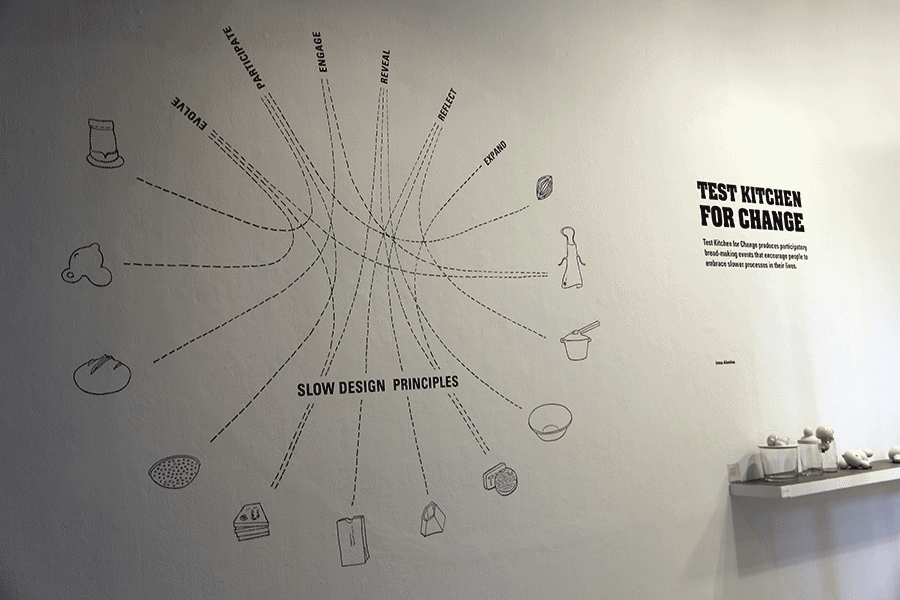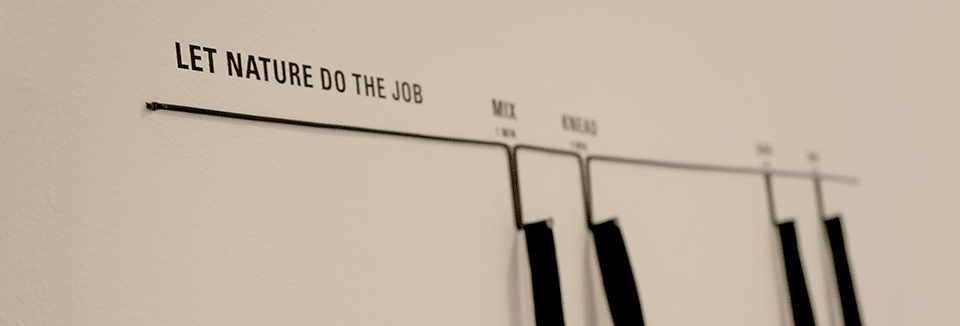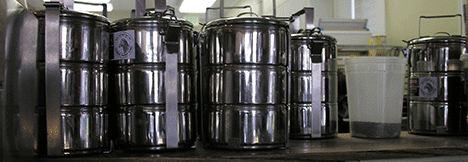


Hand-drawn diagram on the gallery wall illustrates the relationships between the Slow Design principles and the objects designed for the Test Kitchen for Change Object Zoo.

How would someone categorize the Test Kitchen for Change concept? Is it participatory design, speculative design, metadesign, design that changes people’s behaviors, green, or user-centered?
Just as the vast majority of people do not understand what industrial designers do, designers working in the realm of design activism are having trouble deciding how to label themselves. Are we product designers, multidisciplinary designers, system designers, design thinkers, inventors, human centered designers,
eco-designers, even sustainabilists?
I would argue that TKFC adheres to the definition of another category called
Slow Design — a term identified and developed by Alistair Fuad-Luke in his 2002 paper “’Slow Design’— a paradigm for living sustainably.” 1

Apron rack in a shape of the time diagram illustrates the process of sourdough bread-making as brief tasks performed between long stretches of time.
Slow Design (continued)
To understand this recent development requires a brief overview of the field. Since the beginning of the industrial revolution and the mass production of goods, the process of industrial design was more or less linear: artifacts were engineered, manufactured, marketed, consumed, and disposed of. Designers were hired to advance the interest of capitalists, creating goods to be manufactured and systems of manufacture to be made more efficient. Yet there have always been designers and thinkers who gravitated to the edges of the design field. They were and still are human equivalents of the canary in the coalmine. Sensitive to social and human needs, these designers are empathetic to the concerns of the user and the environment.
This socially minded development in design has historical roots in the Arts and Crafts movement. At a time when most mass produced objects were pretentiously decorated, William Morris, the movement’s foremost theorist, said in a speech titled “The Lesser Arts” (1877), “…nothing can be a work of art which is not useful.” The British Arts and Crafts movement (1850-1924) opposed industrial mass-production in favor of the “useful and beautiful”, followed by Deutscher Werkbund (1907-1935), interested in creating functional and affordable objects to improve people’s lives. In the late 1960s and early 1970s, prominent thinkers – like Victor Papanek – argued that people who solve problems every day also practice design, even though they are not trained designers.
Most design is practiced non-intentionally. Papanek wrote in his polemical book Design for the Real World: “All men are designers. All that we do, almost all the time, is design, for design is basic to all human activity.” 2 Similarly, the scientist and sociologist Herbert Simon wrote: “Everyone designs who devises courses of action aimed at changing existing situations into preferred ones.” 3
Simon and Papenek are often quoted to show the important role that design plays within a larger context of improving the social and environmental status quo. From those writings the notion of the designer as a professional shifts to the view of everyone as a designer and the user centered design definition of design activism.
There are many examples of design-led activism such as R. Buckminster Fuller’s geodesic dome (1954), which addressed the need to conserve the earth’s resources. Thus it utilized a minimum amount of material to cover a maximum amount of space. 4 A radio designed by Victor Papanek and George Seegerm was open source and cost only nine cents to produce.Still, while the arts enjoyed an explosion of outcomes and mediums, including the participatory experiences of the viewers, industrial design, by its definition, was an extension of modern industry and served the purpose of making things usable and attractive.

Campers fill up free
food baskets at the campground in Reykjavik, Iceland.
The next group of arriving travelers happily use the items.

Shiny steel containers line the counter at the Atwaters bakery in Catonsville, Maryland.
‘Tiffin Box Lunches” encourage patrons to bring own soup
containers to reduce the
waste from disposable packaging.
Our ever-accelerating pace of life promotes cheaper and
unhealthier consumption, societal isolation, and damage to
the environment. Learning how to slow down and be in-tune
with nature can help people to leave fulfilled lives.
Empathy in the way of universal design, green design, or design for disassembly mostly dealt with superficial aspects of the form, function, user friendliness and perceived eco friendliness.
Deep research and understanding of materials is essential to designers. However, John Thackara’s book In the Bubble: Designing in the Complex World talks about sustainable systems rather than just green materials. Thackara talks about using scenarios where designers start the design process by envisioning situations and focus on human behaviors rather than artifacts. He also said that designers should “design people in
and not out” of the design process. Thackara uses the term “Lightness” when talking about systems that allow humans to share usage of things, minimize energy and integrate slow processes in their lives. He summarizes principles of sustainability and lightness: “Minimize the waste of matter and energy, reduce the movement and distribution of goods, use more people and less matter.”
Thackara brings people and their behaviors in to the picture. The book is about the future, and the topic of speed is frequently alluded to.
Speed is expensive. The greatest cost comes from ecological impact. Speed equals energy. “Every year, our industrial systems burn as much fossil fuel as the Earth has stored up in a period of nearly a million years,” writes Thackara. In contrast, slow equals quality of life. However, Thackara argues that redesigning fast systems to become slow will not work; instead we need systems with various speeds: “Multiple tempos - some fast, some slow - can coexist, but they have to be desirable and they have to be designed.” 5
The international Slow Food movement and the lesser known but growing SLOW movement includes slow money, slow cities, slow travel, and slow living. Such examples as The Sustainable Everyday Project (SEP), Open IDEO and other open web platforms designed to stimulate social conversation on possible sustainable future scenarios generate many design concept that employ slower systems such as whole foods, biking, communal kitchens, gardening and systems for shared use.
The principals of Slow Design are slowly trickling down to our fast-paced world. We can only hope it is more than just a trend, but rather a solution.

In 2003 Carolyn F. Strauss founded slowLab, a research
‘laboratory’ for Slow Design thinking and creative activism.
Strauss and Alastair Fuad-Luke co-authored the
Slow Design Principles, where they outlined six
principles
of Slow Design. 6
REVEAL
Slow design reveals experiences in everyday life that are often missed or forgotten, including the materials. The Bread Stones and Bread Stamps are good examples of this principle. Designs on the bread would reveal after the baking.
EXPAND
Slow design considers the real and potential “expressions” of artifacts and environments beyond their perceived functionalities, physical attributes and lifespans. The Bread Stamps expand perceived function of objects such as an old ashtray or wooden trivet.
REFLECT
Slow Design artifacts/environments/experiences induce contemplation and what slowLab has coined “reflective consumption”. Salt Pour is made in the shape resembling salt crystal. The size of the container helps to visualize the size, which in the case of salt needs to be carefully considered.
2 Papanek, Victor (1974) Design for the Real World: Human Ecology
and Social Change, Paladin, St Albans, UK, (p.17)
3 Simon, H (1996) The Sciences of the Artificial , MIT Press,
Cambridge, MA; republication of the original 1969 version.
4 Gorman, Carma (2003) The Industrial Design Reader,
Allworth Press, New York (p.186)
5 Thackara John (2005) In The Bubble: Designing in a Complex World,
The MIT press, Cambridge, Massachusetts, London.
6 www.slowlab.net/CtC_SlowDesignPrinciples.pdf
ENGAGE
Slow Design processes are open-source and collaborative, relying on sharing, cooperation, and transparency of information so that designs may continue to evolve into the future. All of the bread zoo objects designed with this principle in mind, yet the actual loaf of bread is the best representatation of this principle.
PARTICIPATE
Slow Design encourages users to become active participants in
the design process, embracing ideas of conviviality and exchange to foster social accountability and enhance communities. TKFC is an example of participatory design. The object that reflects this the most is
the Double Juicer.
EVOLVE
Slow Design recognizes that richer experiences can emerge from the dynamic maturation of artifacts, environments and systems over time. Looking beyond the needs and circumstances of the present day, slow designs are (behavioral) change agents. There are several objects in this collection designed to become better with time. Examples are: Dutch Oven and Tool, Adept Apron, and the sourdough culture.